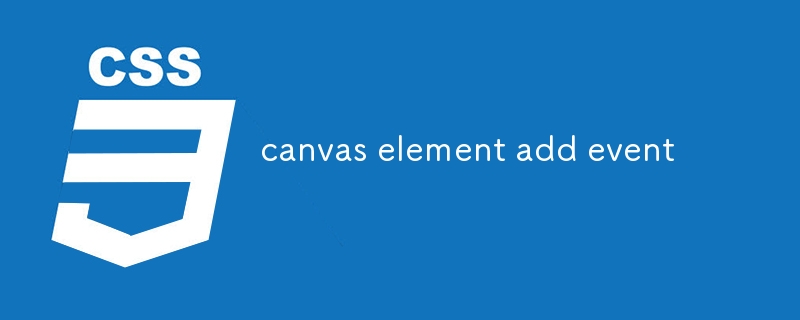Home >Web Front-end >CSS Tutorial >canvas element add event
canvas element add event
- DDDOriginal
- 2024-08-15 14:12:211119browse
This article provides guidance on event listening for canvas elements in HTML. It describes how to use the addEventListener() method to handle various events, including mouse, keyboard, pointer, drag, touch, and canvas-specific events. Additionally,

How do I listen for events on a canvas element?
You can listen for events on a canvas element using the addEventListener() method. This method takes two arguments: the event type and a function to be executed when the event occurs. For example, the following code listens for the click event on a canvas element:addEventListener() method. This method takes two arguments: the event type and a function to be executed when the event occurs. For example, the following code listens for the click event on a canvas element:
<code>canvas.addEventListener('click', (event) => {
// Handle click event
});</code>
What are the different types of events I can add to a canvas element?
There are a variety of events that you can listen for on a canvas element, including:
-
Mouse events:
click,dblclick,mousedown,mouseup,mousemove,mouseover,mouseout,wheel -
Keyboard events:
keydown,keyup,keypress -
Pointer events:
pointerdown,pointerup,pointermove,pointerover,pointerout,pointerenter,pointerleave,gotpointercapture,lostpointercapture -
Drag events:
drag,dragstart,dragend,dragenter,dragleave,dragover,drop -
Touch events:
touchstart,touchend,touchmove,touchcancel -
Canvas-specific events:
contextmenu,webglcontextlost,webglcontextrestored
How can I capture and process pointer events on a canvas element?
To capture and process pointer events on a canvas element, you can use the requestPointerLock() method. This method takes a single argument, which is the element that you want to capture pointer events for. For example, the following code captures pointer events for a canvas element:
<code>canvas.requestPointerLock();</code>
Once you have captured pointer events, you can listen for them using the addEventListener() method. The following code listens for the pointermove
<code>canvas.addEventListener('pointermove', (event) => {
// Handle pointermove event
});</code>🎜What are the different types of events I can add to a canvas element?🎜🎜🎜There are a variety of events that you can listen for on a canvas element, including:🎜- 🎜Mouse events:🎜
click,dblclick,mousedown,mouseup,mousemove,mouseover,mouseout,wheel - 🎜Keyboard events:🎜
keydown,keyup,keypress - 🎜Pointer events:🎜
pointerdown,pointerup,pointermove,pointerover,pointerout,pointerenter,pointerleave,gotpointercapture,lostpointercapture - 🎜Drag events:🎜
drag,dragstart,dragend,dragenter,dragleave,dragover,drop - 🎜Touch events:🎜
touchstart,touchend,touchmove,touchcancel - 🎜Canvas-specific events:🎜
contextmenu,webglcontextlost,webglcontextrestored
requestPointerLock() method. This method takes a single argument, which is the element that you want to capture pointer events for. For example, the following code captures pointer events for a canvas element:🎜rrreee🎜Once you have captured pointer events, you can listen for them using the addEventListener() method. The following code listens for the pointermove event on a canvas element:🎜rrreeeThe above is the detailed content of canvas element add event. For more information, please follow other related articles on the PHP Chinese website!
Related articles
See more- Detailed explanation of the difference between link and @import in CSS
- Summary of clear float methods using CSS
- 7 recommended articles about hardware acceleration
- CSS style implementation of small triangle example on the right side of selection box
- Introduction to mix-blend-mode/background-blend-mode of CSS3

